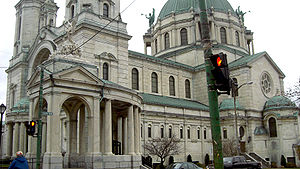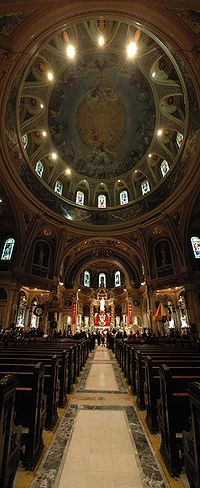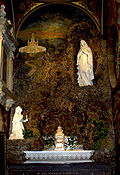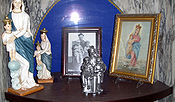- Our Lady of Victory Basilica (Lackawanna, New York)
-
The Basilica of Our Lady of Victory is a national shrine and Roman Catholic parish located in Lackawanna, New York. Due to the multiple charities of founder Father Nelson Baker, the shrine is a popular pilgrimage and visitor destination in Lackawanna.
Contents
History
Construction on the Basilica began in 1921 after Father Baker unveiled plans for a shrine paying homage to the Blessed Mother before a routine parish council meeting. Because of Baker's influence in the community and well-known charitable reputation across the nation, construction began almost immediately. Baker sent out calls of support for his project, and thousands from across the nation contributed funding both large and small, mostly through a direct-mail fundraising club. The basilica was constructed at a cost of $3.2 million, but the project was completed without going into debt.[1]
By late 1925, construction on the sanctuary of Our Lady of Victory was complete and the first mass was held there on Christmas of that year. On May 25, 1926, a consecration ceremony took place presided over by Father Baker, Bishop William Turner of the Diocese of Buffalo, and Cardinal Patrick Hayes. Thousands of priests, nuns, and believers from across the nation attended the event. Two months later, Pope Pius XI designated the shrine the honorable title of "Minor Basilica" via an apostolic decree. Baker was in charge of the Basilica and the parish's various institutions of charity until his death on July 29, 1936.
Throughout the years, the Basilica saw only two changes to its original design. The first came in 1941 during a violent lightning storm that caused significant damage to the basilica's original twin towers. Baker's first successor Monsignor Joseph Maguire, took charge of the efforts to refurbish the structures, replacing the original marble towers with the lower, enclosed, copper dome-tipped towers that can be seen on the basilica today. The second change came during the harsh winter of 2001-2002. The roof of the National Shrine was significantly deteriorated, turning the original shiny copper to a greenish hue due to overexposure to the elements (a similar chemical effect as seen on the Statue of Liberty), hence a new copper roof had to be installed.
In 2001, a celebration of the National Shrine's Diamond Jubilee and basilica's 75 years in the making was held at the Our Lady of Victory Parish. On May 26, a special mass was followed by a dinner party, at which hundreds of dignitaries, clergy members, and friends came together to celebrate the Basilica and Father Baker's legacy.
Relics of Father Baker
In July 1998, through the efforts of Bishop Henry J. Mansell, it was announced that the earthly remains of Father Baker would be moved from the nearby Holy Cross Cemetery to the Basilica. The move was ordered by the Congregation for the Causes of Saints in Rome, to signify a step towards declaring Baker a saint. On March 11, 1999, Father Baker's casket was carried by six men who were raised by Baker himself, and placed in a sarcophagus within the Grotto Shrine to Our Lady of Lourdes, found on the southern end of the Basilica's transept. It is estimated that nearly 6,000 people attended the event at the Basilica that day to honor Baker and his accomplishments. The move also helped raise awareness of Baker, his mission, and his legacy across the world.
Architecture
Exterior
The design of the exterior of the basilica was the work of French ecclesiastical architect, Emile Ulrich. To fulfill Father Baker's wish for the finest materials and workmanship, Ulrich halted all other projects from his architectural firm in Cleveland and spent his time personally inspecting artists' work both in the United States and Europe.[2]
The majority of the exterior of the shrine is constructed almost entirely of pure white marble, originally from the Georgia Marble Company of Tate, Georgia. Throughout the Basilica's interior and parts of the exterior, a combination of more than 40 different types, colors, and designs of Italian marble can also be found.
The Great Dome
A prominent feature of the Basilica's exterior is the large copper dome. The dome, measuring 165 feet in height, was second in size only to the U.S. Capitol building in Washington, D.C. at the time of its completion in 1926. Over the years, the dome's original copper has aged to a green patina. Four copper angel statues playing trumpets, measuring 18 feet tall, are mounted on the dome.
The Twin Towers
The original twin towers of the Basilica, when completed in 1926, stood at a height of 165 feet (about 16 stories). The spires were made completely of marble and had an open design. In 1941, a violent lightning storm caused major damage to both the towers, forcing redesign and refurbishing. The new towers, enclosed and much shorter than the originals, are topped with copper domes, similar to the design of the Basilica's Great Dome.
The Main Entrance
Two large colonnades extend outward and flank the exterior sides of the shrine at the main entrance. On top of each is a marble sculpture of a group of children overseen by a large angel. On the left colonnade (when facing the Basilica's front), the children are led by a nun. This figure represents the Sisters of St. Joseph, the order which has staffed the Our Lady of Victory Institutions since 1856. On the right colonnade, the children are led by a priest, Father Baker. This figure of Baker was ordered by Ulrich to honor the priest for his several contributions to the Our Lady of Victory Institutions. Also at the entrance to the Basilica is a domed niche that houses a 12-foot-tall, 16,000 pound (eight tons), statue of Our Lady of Victory, crafted of the finest carerra marble available.
Interior
The Great Dome and Ceiling
The largest work of art is the decoration of the Great Dome, 80 feet (24 m) in diameter, which depicts the Assumption of Mary and the Blessed Mother's Coronation. Around the dome's outer edge, the 12 apostles and three archangels are shown, while an angelic host carries Mary towards heaven. Slightly higher within the dome, Jesus in red robes can been seen awaiting her. At the pinnacle of the dome, 120 feet (37 m) above the basilica floor, depicts a white Dove of Peace looking down from Heaven at the basilica.[3]
From the Great Dome to the choir loft, the ceiling is covered by five giant murals. They depict Mary as Queen of Patriarchs, Queen of the Apostles, Queen of the Angels, Queen of the Prophets, and Queen of the Martyrs. The two walls on the Basilica's sides feature huge paintings depicting the Slaughter of the Innocents, the Flight into Egypt, and the Birth of Jesus at Bethlehem.
The Main Altar
The main altar features a 9 feet (2.7 m) tall, 1,600 pounds (730 kg) statue of Our Lady of Victory. This was blessed by Pope Pius XI after being sculpted in Italy. Baker placed a painting of the pope on the altar in return.
Flanking the altar are four swirled marble columns of rare red marble, reminiscent of St. Peter's Basilica in Rome. A legend is told about the marble that says a group of Buffalo-born soldiers stumbled upon the unique red marble while in Spain during World War I. Upon seeing it, the soldiers thought immediately of the basilica being built back home by Father Baker, and they went to talk to the Spanish farmer who owned the property the marble was on. After hearing the story of Father Baker, the farmer agreed to donate the "useless rock" on his property. Arrangements were made and the marble was soon sent to Lackawanna to complete the work on the basilica's altar.[4]
The main altar stands under a bright blue dome depicting the Holy Spirit in brilliant hues. On the ceiling over the altar, an elongated panel represents "Queen of All Saints." Among the saints are Mary Magdalene, St. Anthony, St. Elizabeth, St. Anne, and St. Theresa.[3]
Items of Papal Significance
Near the altar, at one end of the pews, stands the canopeum, a symbolic shield which remains half open until the Pope visits the basilica and completely opens it. The tintinnabulum, a small gold bell mounted on a pole with a golden frame, stands at the other end, and is used to lead the procession when the Pope says mass within the basilica. These two items, along with the Papal Coat of Arms, which hangs above the bronze main entrance doors, signify the shrine's Basilica status within the Catholic community.
The Stations of the Cross
The shrine is flanked by the 14 marble Stations of the Cross, which depict Jesus' final hours before his death. Rather than being carved from separate blocks of marble and being assembled afterwards, each Station was sculpted from single blocks. The figures are depicted at life size. The Italian sculptor, Pepini, spent 14 years on the design and execution.[4]
The station entitled "Jesus Meets His Afflicted Mother" holds a special place as Father Baker's favorite places in the Basilica. Baker, in his 80s by the time the Basilica was completed, could be often found leaning on the pillar closest to this Station, meditating and saying prayers.[3]
The Organ
When the original, custom-made Wurlitzer organ installed the choir loft had deteriorated beyond repair, a specially-designed 54-rank pipe organ was installed in its place. Built by the Delaware Pipe Organ Co. and installed in 1981, the organ has three mahogany pipe towers, each in an eight-foot semicircle, representing the Holy Trinity. There are 51 pipes in the three towers with the balance of pipes located behind the towers. The pipework is of metal and wood and ranges in length from six inches to 18 feet.
The Grotto and Father Baker's Remains
Baker's remains are in a sarcophagus within the Grotto Shrine to Our Lady of Lourdes, found on the southern end of the Basilica's transept. The Grotto is hewn out of black lava rock from Mount Vesuvius in Italy. Baker, who had died in 1936,[5] had wanted to find a construction material that was "untouched by humans" to commemorate the vision of the Blessed Mother to St. Bernadette in Lourdes, France.[1]
Other Places of Interest
Other Sculptures and Artwork: The interior is decorated with several religious paintings, sculptures, and mosaics depicting devotion to the Blessed Mother. It is estimated that from 1,500 to 2,500 angels can be found in the basilica in the sculptures and artwork. It was Baker's plan to place an angel in every possible sightline, to remind visitors that although the Basilica is dedicated to Our Lady of Victory, its main purpose is meant primarily for God's praise and glory.[3]
The Pews and Aisle: The Basilica's pews are made of rare African mahogany, and provide seating for more than 1,200 individuals. Similar to the design of sports arenas, the shrine's floor and aisle are gradually sloped, to ensure that visitors have an unobstructed view of the Basilica's main altar.
The Altars: In keeping with the style of architecture the artists had chosen for the Basilica, five unique altars line the rear wall behind the Main Altar. These altars are dedicated to: St. Patrick, St. Aloysius, Mary Immaculate, St. Anne, and St. Vincent de Paul, whose life work with the poor and needy served as inspiration for Father Baker's own life.
The Baptistery: Located adjacent to the Main Altar, the Bapistery features a marble baptismal font as well as dozens of wall and ceiling paintings of with religious symbols and peoples.
The Father Baker Museum: During late 2009, construction went underway to create a small museum about Father Baker's life and the history of the Our Lady of Victory Institutions. It is located in the Basilica's basement, where the chapel and Father Baker Rooms were formerly located. After going through the museum, the exit goes out and through the remodeled gift shop. A number of photos, official documents, vintage newspapers, and Baker's actual belongings are on display for visitors to see. Items such as Father Baker's desk, books, clothing, and furniture can be found throughout the museum. Also in the museum are cases of photos, information, and memorabilia from the Our Lady of Victory Institutions, such as the Infant Home, Orphanage, Protectory, and the Basilica itself.
Gallery
-
A panning shot of the side and front exterior.
-
A pan down shot of the grotto shrine to Our Lady of Lourdes containing the sacrophagus that holds Father Nelson Baker's remains.
-
A pan down shot from the Great Dome to the main altar.
-
A circular pan shot showing the detail of the artwork and stained glass windows on the interior of the Great Dome.
-
A tracking shot of a few of the saint altars that line the rear wall behind the main altar.
References
- ^ a b "A Brief History of the Our Lady of Victory Basilica & National Shrine". Our Lady of Victory Institutions website. Our Lady of Victory Institutions, Lackawanna. 2007. http://www.ourladyofvictory.org/Basilica/bashistory.html. Retrieved 2008-10-28.
- ^ "On-Line Tour of the Our Lady of Victory Basilica & National Shrine - Exterior". Our Lady of Victory Institutions website. Our Lady of Victory Institutions, Lackawanna. 2007. http://www.ourladyofvictory.org/Basilica/tourex.html. Retrieved 2008-11-23.
- ^ a b c d "On-Line Tour of the Our Lady of Victory Basilica & National Shrine - Interior". Our Lady of Victory Institutions website. Our Lady of Victory Institutions, Lackawanna. 2007. http://www.ourladyofvictory.org/Basilica/tourin.html. Retrieved 2008-11-23.
- ^ a b "The City of Lackawanna Web Site: Our Lady of Victory Basilica & National Shrine". City of Lackawanna website. City of Lackawanna. 2006–2007. http://www.ci.lackawanna.ny.us/basilica.htm.
- ^ "The Father Baker Story: Twilight". Our Lady of Victory Institutions website. Our Lady of Victory Institutions, Lackawanna. 2002. http://www.ourladyofvictory.org/FatherBaker/twilight.htm. Retrieved 2008-10-29.
External links
Categories:- Religious buildings completed in 1926
- 20th-century Roman Catholic church buildings
- Roman Catholic churches in New York
- Basilica churches in the United States
- Churches in Erie County, New York
- Visitor attractions in Erie County, New York
- Museums in Erie County, New York
- Religious museums in New York
- Biographical museums in New York
Wikimedia Foundation. 2010.
























